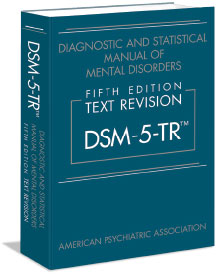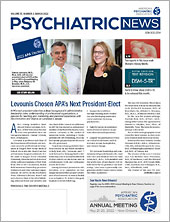Q. How was DSM-5-TR developed?
A. DSM-5-TR is a text revision of DSM-5 and includes revised text and new references, clarifications to diagnostic criteria, and updates to ICD-10-CM codes since DSM-5 was published in 2013. It features a new disorder, prolonged grief disorder, as well as ICD-10-CM codes for suicidal behavior and nonsuicidal self-injury. DSM-5-TR is based on updates to the scientific literature since the publication of DSM-5 in 2013 and involved the help of over 200 subject matter experts. More information about its development is provided in the DSM-5-TR “Introduction” in Section I.
Q. What is the difference between a text revision of DSM and a new edition?
A. A text revision of DSM is released when a number of changes to the text that accompanies the description of disorders and their criteria are warranted by new evidence or the need for more clarity. Although the text of DSM-5 had occasional corrections since its release in 2013, DSM-5-TR was a systematic text revision based on the literature in the 10 years since the development of DSM-5. In contrast, a new edition of DSM is released when there are enough advances in the field to support the creation, substantive revisions, and elimination of multiple diagnostic criteria sets or disorders.
Q. What important changes to DSM-5-TR appear in the new edition?
A. These are the major changes from DSM-5 to DSM-5-TR:
•
Revised text for almost all disorders with updated sections on associated features, prevalence, development and course, risk and prognostic factors, culture, diagnostic markers, suicide, and differential diagnosis
•
Addition of the new diagnosis of prolonged grief disorder to Section II
•
Over 70 modified criteria sets with helpful clarifications since publication of DSM-5
•
Fully updated “Introduction” and “Use of the Manual” to guide usage and provide context for important terminology
•
Considerations of the impact of racism and discrimination on mental disorders integrated into the text
•
New ICD-10-CM codes to flag and monitor suicidal behavior and nonsuicidal self-injury that can be used without the requirement of another diagnosis
•
Updated ICD-10-CM codes implemented since 2013, including over 50 coding updates new to DSM-5-TR for substance intoxication and withdrawal and other disorders
Q. Are there changes in the manual that might affect a patient’s diagnosis or insurance coverage?
A. The text revisions in DSM-5-TR should not affect insurance coverage or result in changing diagnoses that have already been made. The manual, however, includes a new disorder—prolonged grief disorder—with billable ICD-10-CM code, F43.8.
Q. How are the roles of racism, cultural considerations, and the social determinants of mental health in determining diagnoses and their impact on mental health addressed in DSM-5-TR?
Q. How can the new ICD-10-CM codes for suicidal behavior and nonsuicidal self-injury be used?
A. Because suicidal behavior may be helpful to track or flag for clinical attention and care of individuals, ICD-10-CM codes are now available for use by any clinician and do not require a mental disorder diagnosis. The suicidal behavior ICD-10-CM codes can be used for individuals who have engaged in potentially self-injurious behavior with at least some intent to die as a result of the act. Evidence of intent to end their life can be explicit or inferred from the behavior or circumstances. A suicide attempt may or may not result in self-injury.
The nonsuicidal self-injury ICD-10-CM codes can be used for individuals who have engaged in intentional self-inflicted damage to their body that is likely to induce bleeding, bruising, or pain (for instance, by cutting, burning, stabbing, hitting, or excessive rubbing) in the absence of suicidal intent.
These codes appear in the Section II chapter “Other Conditions That May Be a Focus of Clinical Attention”; conditions, behaviors, circumstances, and problems in this chapter do not represent mental disorders but can affect the diagnosis, course, prognosis, or care of a disorder.
Q. What is the process for making changes to DSM?
A. Anyone can initiate the process for consideration of a proposal for changes to
DSM; see
here for more information. Proposals must provide all information requested for consideration; see the
DSM-5 Proposals Submission Guidance Document posted
here. Changes can be made when warranted by evidence from new research without waiting for a new edition of
DSM.
Q. What is prolonged grief disorder, and why is it being recognized as a diagnosis?
A. Years of research and clinical experience indicate that some people experience a persistent inability to overcome their grief for the loss of a loved one for at least one year or more, with intense yearning or preoccupation with thoughts or memories of the deceased person almost every day since the death. These symptoms are severe enough to impair day-to-day functioning. In addition, the duration and severity of the bereavement reaction must clearly exceed what is expected based on standards related to the individual’s social, cultural, or religious background. This does not mean that people feeling grief periodically one year or more after the loss of a loved one have the disorder. However, those with intense and impairing grief after one year may be considered for the diagnosis.
Q. Does creating the diagnosis of prolonged grief disorder have the effect of pathologizing grief?
A. The diagnosis of prolonged grief disorder is not intended to pathologize grief. Individuals who meet the criteria for prolonged grief disorder experience something dramatically different from the grief normally experienced by anyone who loses a loved one. The grief is intractable and disabling in a way that typical grieving is not. People whose symptoms meet the criteria for prolonged grief disorder need and deserve to get appropriate care.
Q. What changes were made to DSM-5-TR related to gender identity and sexual orientation?
A. There have been updates to the terminology to describe gender dysphoria based on updated culturally sensitive language. The term “desired gender” is now “experienced gender,” the term “cross-sex medical procedure” is now “gender-affirming medical procedure,” and the term “natal male”/“natal female” is now “individual assigned male/female at birth.” The entire text of the Gender Dysphoria chapter has also been updated based on the literature.
Q. Why have DSM codes been dropped from DSM-5-TR and only ICD-10-CM codes are used?
A. There are no DSM codes. The codes that appear in DSM are the ICD codes that are equivalent to the DSM diagnoses given the version of the manual. For DSM-5-TR, only ICD-10-CM codes are used because this is the version of ICD that is in effect in the United States. ICD-10-CM stands for the International Classification of Diseases, 10th Edition, Clinical Modification. Although based on the World Health Organization’s ICD-10 codes, ICD-10-CM codes in DSM-5 (and thus DSM-5-TR) have been modified from ICD-10 for clinical use by the U.S. Centers for Disease Control and Prevention’s National Center for Health Statistics (NCHS) and provide the only permissible diagnostic codes for mental disorders for clinical use in the United States. In the United States, the use of ICD-10-CM codes for disorders in DSM-5-TR has been mandated by the Health Care Financing Administration for purposes of reimbursement under the Medicare system. The use of these diagnostic codes is fundamental to medical record keeping and facilitates data collection, retrieval, and compilation of statistical information.
Q. Why are there some changes to criteria sets for mental disorders in DSM-5-TR?
A. As discussed in more detail in the DSM-5-TR “Introduction” section, changes to criteria sets occurred through different formal mechanisms that were separate from the DSM-5-TR text revision process. A formal proposal and review process, across several stages, conducted by the DSM Steering Committee, is necessary for changes to criteria sets. All proposed changes to criteria sets are also reviewed and approved by the APA Assembly and APA Board of Trustees. For some criteria sets, such as the addition of the new prolonged grief disorder, the review process for the criteria had begun before the development of DSM-5-TR started, and formal approval of the criteria set changes coincided with the publication of DSM-5-TR. ■

